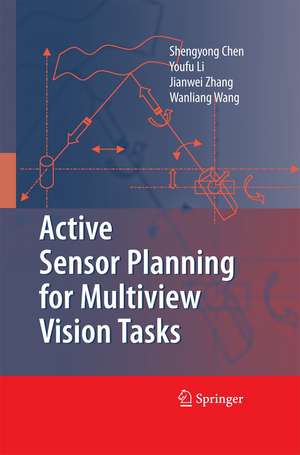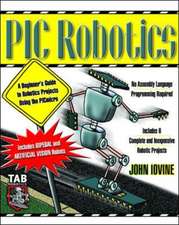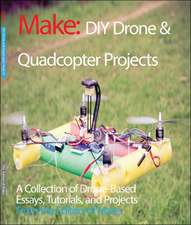Active Sensor Planning for Multiview Vision Tasks
Autor Shengyong Chen, Y. F. Li, Jianwei Zhang, Wanliang Wangen Limba Engleză Paperback – 28 noi 2014
Vision sensors have limited fields of views and can only "see" a portion of a scene from a single viewpoint. To make the entire object visible, the sensor has to be moved from one place to another around the object to observe all features of interest. The sensor planning presented in this book describes an effective strategy to generate a sequence of viewing poses and sensor settings for optimally completing a perception task. Several methods are proposed to solve the problems in both model-based and nonmodel-based vision tasks. For model-based applications, the method involves determination of the optimal sensor placements and a shortest path through these viewpoints for automatic generation of a perception plan. A topology of viewpoints is achieved by a genetic algorithm in which a min-max criterion is used for evaluation. A shortest path is also determined by graph algorithms. For nonmodel-based applications, the method involves determination of the best next view and sensor settings. The trend surface is proposed as the cue to predict the unknown portion of an object or environment.
The 11 chapters in Active Vision Planning draw on recent work in robot vision over ten years, particularly in the use of new concepts of active sensing, reconfiguration, recalibration, sensor model, sensing constraints, sensing evaluation, viewpoint decision, sensor placement graph, model based planning, path planning, planning for robot in unknown environment, dynamic 3D construction,surface prediction, etc. Implementation examples are also provided with theoretical methods for testing in a real robot system. With these optimal sensor planning strategies, this book will give the robot vision system the adaptability needed in many practical applications.
| Toate formatele și edițiile | Preț | Express |
|---|---|---|
| Paperback (1) | 943.73 lei 6-8 săpt. | |
| Springer Berlin, Heidelberg – 28 noi 2014 | 943.73 lei 6-8 săpt. | |
| Hardback (1) | 789.37 lei 38-45 zile | |
| Springer Berlin, Heidelberg – 11 feb 2008 | 789.37 lei 38-45 zile |
Preț: 943.73 lei
Preț vechi: 1150.89 lei
-18% Nou
Puncte Express: 1416
Preț estimativ în valută:
180.59€ • 193.11$ • 150.57£
180.59€ • 193.11$ • 150.57£
Carte tipărită la comandă
Livrare economică 18 aprilie-02 mai
Preluare comenzi: 021 569.72.76
Specificații
ISBN-13: 9783642437373
ISBN-10: 3642437370
Pagini: 280
Ilustrații: XI, 265 p.
Dimensiuni: 155 x 235 x 15 mm
Greutate: 0.4 kg
Ediția:2008
Editura: Springer Berlin, Heidelberg
Colecția Springer
Locul publicării:Berlin, Heidelberg, Germany
ISBN-10: 3642437370
Pagini: 280
Ilustrații: XI, 265 p.
Dimensiuni: 155 x 235 x 15 mm
Greutate: 0.4 kg
Ediția:2008
Editura: Springer Berlin, Heidelberg
Colecția Springer
Locul publicării:Berlin, Heidelberg, Germany
Public țintă
ResearchCuprins
Active Vision Sensors.- Active Sensor Planning – the State-of-the-Art.- Sensing Constraints and Evaluation.- Model-Based Sensor Planning.- Planning for Freeform Surface Measurement.- Sensor Planning for Object Modeling.- Information Entropy Based Planning.- Model Prediction and Sensor Planning.- Integrating Planning with Active Illumination.
Textul de pe ultima copertă
Vision sensors have limited fields of views and can only "see" a portion of a scene from a single viewpoint. To make the entire object visible, the sensor has to be moved from one place to another around the object to observe all features of interest, which brings a multiview vision task that has to be solved by means of active perception. The sensor planning presented in this book describes some effective strategies to generate a sequence of viewing poses and sensor settings for optimally completing a perception task. Several methods are proposed to solve the problems in both model-based and nonmodel-based vision tasks. For model-based applications, the method involves determination of the optimal sensor placements and a shortest path through these viewpoints for automatic generation of a perception plan. For nonmodel-based applications, the method involves determination of the best next view and sensor settings, to incrementally acquire the object information and to find geometrical cues to predict the unknown portion of an object or environment.
The ten chapters in Active Vision Planning draw on recent work in robot vision over ten years, particularly in the use of new concepts of active sensing, reconfiguration, recalibration, sensor modeling, sensing constraints, sensing evaluation, viewpoint decision, sensor placement graph, model based planning, path planning, planning for robot in unknown environment, dynamic 3D construction, surface prediction, etc. Implementation examples are also provided with theoretical methods for testing in a real robot system. With these optimal sensor planning strategies, this book will give the robot vision system the adaptability needed in many practical applications.
The ten chapters in Active Vision Planning draw on recent work in robot vision over ten years, particularly in the use of new concepts of active sensing, reconfiguration, recalibration, sensor modeling, sensing constraints, sensing evaluation, viewpoint decision, sensor placement graph, model based planning, path planning, planning for robot in unknown environment, dynamic 3D construction, surface prediction, etc. Implementation examples are also provided with theoretical methods for testing in a real robot system. With these optimal sensor planning strategies, this book will give the robot vision system the adaptability needed in many practical applications.
Caracteristici
Presents uniquely the very important topic for almost all advanced robots Provides the readers with a clear idea and deep studies of the topics Includes supplementary material: sn.pub/extras










